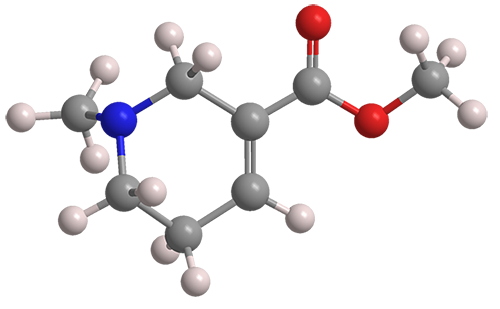What molecule am I?


Arecoline is an alkaloid ester found in the seeds of the betel nut palm, which is also called areca palm from its scientific name, Areca catechu. The term “betel nut” is a bit confusing because South and Southeast Asians often chew it along with betel leaf from the vine of the same name (Piper betle). The two plants are not biologically related.
Arecoline has been known since 1891, when German pharmacist E. Jahns isolated it from A. catechu seeds. The first synthesis was reported by Fritz Chemnitius1 at Jena University (Germany) in 1926. It is a moderately strong base, with a pKb value of 6.8. It is miscible with water and most organic solvents. The carboxylic acid corresponding to the arecoline ester is called arecaidine; it also exists in betel nuts.
People consume betel nuts because they provide a “high” similar to that caused by nicotine. Arecoline, however, acts on different receptors than does nicotine: muscarinic (rather than nicotinic) acetylcholine receptors, especially M4, which may be the cause of its effects on the parasympathetic nervous system. Similarly to nicotine, arecoline is addictive. Chewing betel nuts is also dangerous because they contain ingredients that can cause cancers of the mouth and the esophagus.
1. Chemnitius is also known for his 1932 article about chemistry at Jena University from 1629 to 1921.
Arecoline hazard information
| Hazard class* | Hazard statement | |
|---|---|---|
| Acute toxicity, oral, category 4 | H302—Harmful if swallowed | |
*Globally Harmonized System of Classification and Labeling of Chemicals. Explanation of pictograms.
This molecule was suggested by a reader. We present almost all of the molecules suggested by our readers. If you have a molecule you would like us to consider, please send us a message. And thank you for your interest in Molecule of the Week! —Ed.
Arecoline fast facts
| CAS Reg. No. | 63-75-2 |
| SciFinder nomenclature | 3-Pyridinecarboxylic acid, 1,2,5,6-tetrahydro-1-methyl, methyl ester |
| Empirical formula | C8H13NO2 |
| Molar mass | 155.19 g/mol |
| Appearance | Colorless oily liquid |
| Melting point | 27 ºC |
| Boiling point | 209 ºC |
| Water solubility | Miscible |

Learn more about this molecule from CAS, the most authoritative and comprehensive source for chemical information.
Molecule of the Week needs your suggestions!
If your favorite molecule is not in our archive, please send us a message. The molecule can be notable for its current or historical importance or for any quirky reason. Thank you!
Stay Ahead of the Chemistry Curve
Learn how ACS can help you stay ahead in the world of chemistry.

